How many times has Netflix recommended just the right TV show for you to binge-watch? Or has Amazon suggested the perfect book for you to buy? Or your favourite news site sent you an email full of handpicked articles that are exactly what you want to read?
These are all examples of dynamic content, which web designers and content creators can use to alter forms, CTAs, images, emails and other content based on a visitor’s profile. When used well, dynamic content can create an experience that feels tailored and curated just for you.
Despite its growing ubiquity, however, few in the education sector appear to be using dynamic content in their marketing efforts. Keep reading to learn why this might be a missed opportunity.

How Do Schools Create Dynamic Content?
Dynamic content – sometimes referred to as smart content or adaptive content – is an umbrella term for any web content that can be changed based on information the publisher has about the person viewing it. This information might be gleaned from the user’s IP address and website cookies, but can also be based on their contact profile information if they have previously converted on your site.
To create dynamic content for your school, you will need a platform capable of doing it. Many marketing automation systems, such as HubSpot and Mautic, offer dynamic content functionality.
Example: With Mautic by HEM, a CRM and marketing automation solution created for educational institutions, schools can build dynamic content within emails.
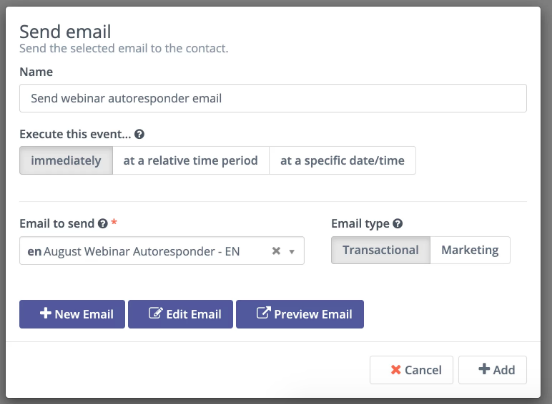
You will also need to be capable of adding it to your website or email marketing efforts, meaning your marketing teams will need to have some level of control over these systems. If all updates to your site are made by your IT department, implementing dynamic content will be a bit more challenging.
Above all else, you will need to ensure that the inquiries you generate are gathered in a centralized database which allows you to easily segment them based on different criteria. Again, a higher ed customer relationship management (CRM) and marketing automation system can offer a robust solution here. Through Mautic by HEM, schools can streamline the management of their marketing efforts, with automation tools to nurture leads and create workflows within one integrated system.
Segmenting Your School’s Audience for Dynamic Content Creation
The key to achieving the desired results from dynamic content is to pinpoint the right segmentation criteria which will allow it to have the maximum impact.
Segmentation is never a one-size-fits-all approach, and the tactics that work best for you will depend on your audience and how different personas differentiate themselves from one another. Below are a few possible ways you could approach this task.
Segmenting in Accordance with the Enrollment Journey
You can create dynamic content that will appeal to prospects at different stages of the enrollment journey. Imagine, for instance, that you write a great blog post which has a broad appeal across your entire audience. People who are discovering your school for the first time, potential applicants who have already made inquiries, applicants considering whether to enroll and even current students and alumni are all likely to read the post in large numbers. So, what offer should your CTA point to at the end of the blog?
If it’s a smart CTA, the answer can depend on the user. New visitors to your site might be prompted to make an inquiry, while those who are already in the system might be encouraged to submit an application, and so on and so forth through the funnel. The end result will be more relevant, valuable offers for your entire online community.
Example: An illustration of a set of simple smart CTAs designed for an ESL school in HubSpot. The default CTA directs users to an English test. However, those who are already in their system and classified as market qualified leads are pushed towards an online quote, while those further down the funnel at the sales qualified stage are encouraged to book.
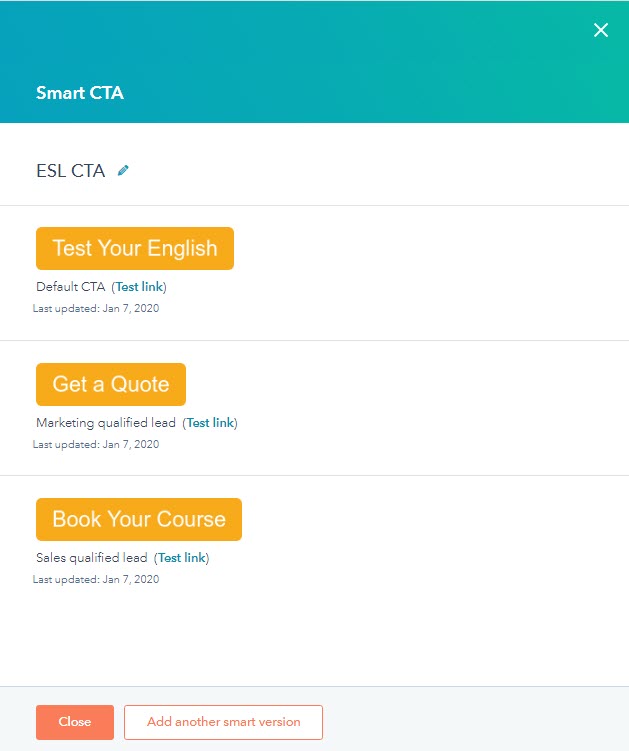
Geographic Segmentation
Dynamic content can also be an ideal way to differentiate your digital marketing efforts for prospects from different locations. Schools can create alternate messages for international posts from different target markets, and use either the contact information you have for existing leads in your CRM or their IP address to determine what content is shown.
This can be a great way to craft your CTAs, forms, landing pages, blog recommendations, and other web elements to better appeal to the unique motivations of prospects from different backgrounds and cultures.
By Program of Interest
Does your school offer courses in a variety of different fields, levels, or formats? If so, you can use dynamic content to show your existing leads more relevant offers based on the programs they have shown interest in.
Example: This Harvard Business School Online article on the subject of product innovations includes an offer for a downloadable guide in pursuing entrepreneurship. A dynamic content engine could be used to curate recommendations like this based on relevant topics and a user’s page viewing history.

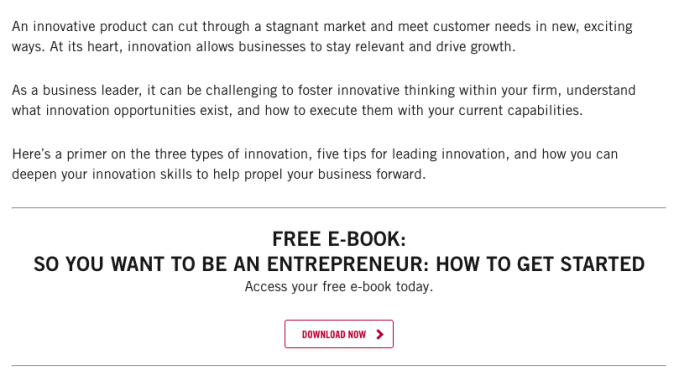
Source: Harvard Business School Online
Segmenting by program of interest can usually be done by creating lists for each program within your CRM and marketing automation system, then using them as your trigger criteria for whatever type of content you are generating.
Segmenting Based on Previous Activity
You can also base dynamic content on a user’s previous activity. The most common example of this would be using dynamic elements to eliminate the need for those who have already submitted their contact details to complete forms again in order to download or access other offers.
Alternatively, your website could use cookies to drive recommendations of blogs, videos and other content based on a user’s browsing history. More sophisticated systems might even be able to prompt users who have abandoned filling out quotes or step-by-step application forms to finish their submissions.
Segment by Device Type
While using responsive design will ensure that your content renders well on the smaller screens of tablets or phones, it can still be an imperfect solution. Often, the elements which are included on desktop versions of a school’s website are simply too varied for mobile.
Large blocks of text, long forms, and large images can all elongate your pages and force users to scroll down for a long time to find what they need. Many marketers remedy this by using responsive content based on device type, and showing abbreviated forms and text on their web pages to mobile and tablet users.
Example: POINT3 Language Center offers a condensed menu on its mobile website, while user options are displayed at the top banner when navigating the website on a desktop.

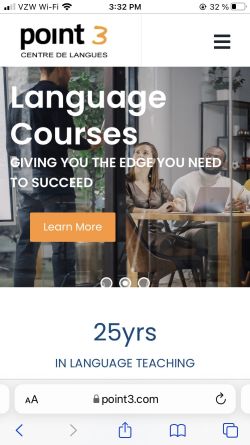
Source: POINT3 Language Center
There are all sorts of other parameters you could use to segment your audience for this purpose, from demographic factors such as their age or gender, to more specific details like the industry a working professional is in. Once you start to think about it, the possibilities are endless.
Types of Dynamic Content for Schools
While it is currently somewhat uncommon in the education sector, there are many potential uses of dynamic content for schools. Depending on the capabilities of your website and the dynamic content generator you are using, this could include any of the following elements.
Calls to Action
Calls to action are one of the most common areas of digital marketing where dynamic content is used. Your school can create alternate versions of CTA buttons that use different text, images, or design elements, and even display different offers.
These CTAs can then be displayed to different users on your website, landing pages, and emails, depending on your segmentation preferences.
HEM often uses dynamic CTAs in blog content to display offers specific to the various needs of schools:



Making your CTAs smart can boost your click-through-rates substantially, while also ensuring that the right prospects receive the right offers at the right time. It also eliminates the problem of a prospect who has already completed a specific action being urged to do so again.
Forms
Just as dynamic CTAs can be used to better align your conversion opportunities to individual users, the same can be done with forms. Dynamic forms can add or remove fields depending on the user.
This can be very handy when it comes to repeat conversions. For instance, you might offer a brochure download with a form that captures the basic details you need from a new lead for your follow-up efforts. But if the person viewing it has already made an inquiry, they won’t want to fill in the same details again, and it is of little to no value to your school, either.
With dynamic content, you could eliminate the need for them to do this, instead showing them a simple button or form to download the brochure.
Alternatively, you could use their reconversion as an opportunity for ‘progressive profiling’. This is where your school uses repeat conversions to gather additional information from a lead that further expands on their profile to give your team a more robust idea of who they are. Each time a lead interacts with your website, they’ll complete a short form, providing necessary information over time without being deterred by a single lengthy questionnaire.
You might also show different forms to new leads based on their segmentation. For example, you may want different information from international leads than you do from local prospects, such as their language levels, visa requirements, accommodation needs, etc. A dynamic system can use a visitor’s IP address to determine their location and show them the correct form.
Images
Dynamic images can also be used on web pages and in emails to add an extra touch of personalization which might be particularly useful for schools. For instance, a university that has identified that a particular prospect is interested in engineering programs could use a dynamic content generator to display pictures of engineering students or professionals on their website and in emails, rather than more general or generic images. It’s a subtle way of reinforcing their interest and keeping their goals top of mind, but it can be very effective.
Blog Recommendations
The dynamic content engines that websites like Amazon and Netflix use to make recommendations to existing users are also commonly used by publishers to suggest similar content to readers of certain articles. By tracking a user’s cookies, they can determine what kind of content interests them, and offer a tailored list of similar pieces.
Schools can make use of this with their own blog pages, helping potential leads find more content that offers targeted information and further pushes them towards conversion.
Example: At the end of this blog post, John Cabot University has recommended similar blogs for students to explore, based on their potential interests.

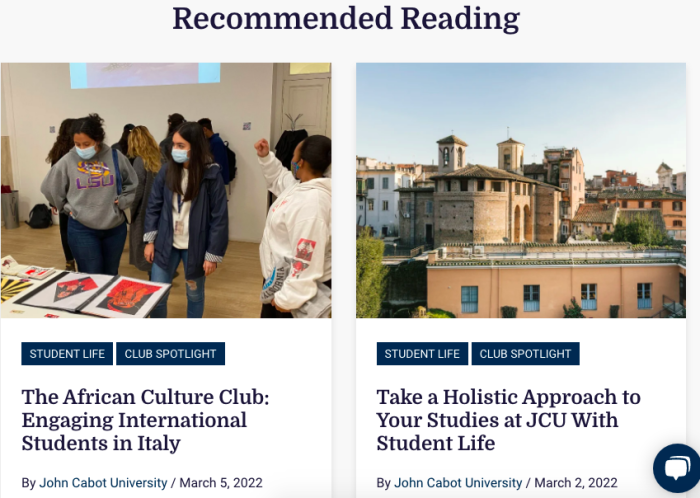
Source: John Cabot University
Recommending similar blog posts helps potential students to see how an institution could meet their needs, making it a great tool for recruitment.
Dynamic Email Content
Email perhaps offers more opportunities for creating dynamic, personalized content than any other digital channel. Because your CRM and marketing automation system can store a myriad of details about your contacts, you have a wealth of knowledge that can be utilized in your smart content.
As mentioned above, emails can house both dynamic CTAs and images which can be personalized for each user. You can also add a number of personalization tokens to address readers by their name in your greetings, in subject lines, and within your body text, as well other tokens based on information in your database about their location, gender, age, program of interest, or any other criteria.
It doesn’t have to stop there, either. You can create radically different versions of entire paragraphs of text that can be included or omitted from mails depending on the specific attributes of the person it is being sent to.
Example: This is a simple example of a dynamic email variant for business schools. Both mails contain personalization tokens that will adapt the content based on the contact’s name, city, and program of interest, but the mail on the right also contains a personalized paragraph designed specifically for prospects from New York.
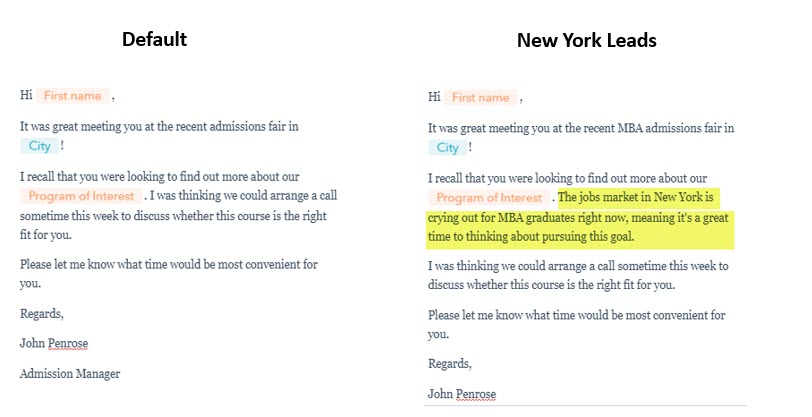
In essence, using dynamic email content has much the same effect as creating alternate versions of mails to send to different segments, but can be far more time-efficient and offers even more opportunities for precise personalization.
When and When Not to Use Dynamic Content in Your Education Content Marketing Strategy
While it might be tempting to use dynamic content wherever you can, it’s important not to overdo it. Dynamic web elements need to be designed with a clear purpose, and a solid basis for differentiating what one prospect sees versus another.
When not done with the proper forethought and planning, dynamic content can be ineffective, or even worse, off-putting to prospects who might feel self-conscious of you tracking their activities to such an extent. Avoiding the ‘creep factor’ when creating your education content marketing strategy is essential.
However, when used sparingly and with the aim of providing a better user experience, dynamic content can be a way to provide added value to both you and your target audience.
*This post was originally published 15 January 2020, but has been updated to reflect current industry statistics and trends.
















